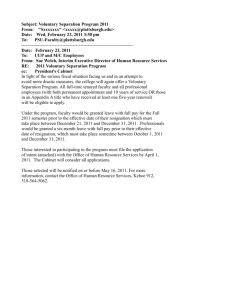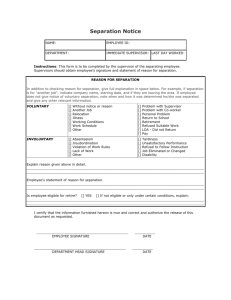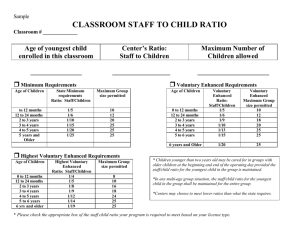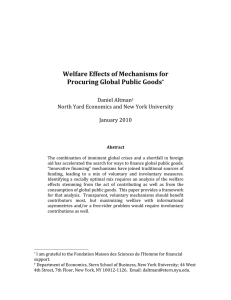LESSON 10
advertisement
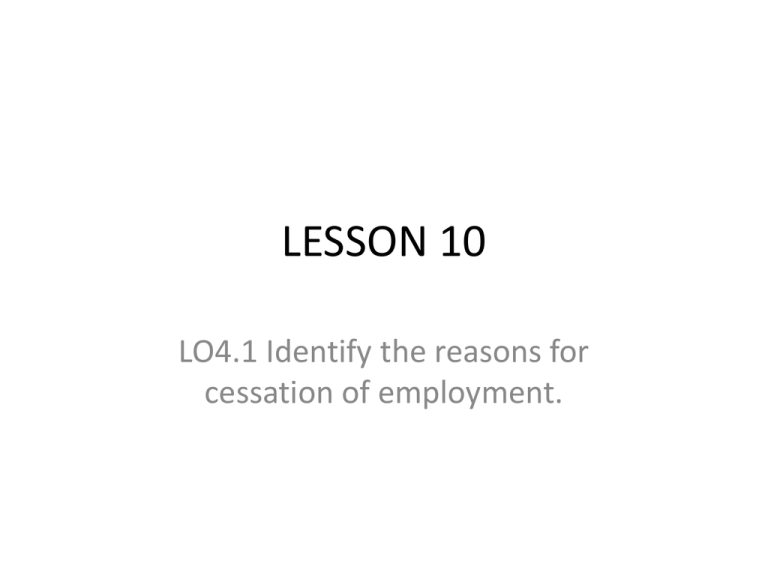
LESSON 10 LO4.1 Identify the reasons for cessation of employment. Definitions Cessation of employment - the separation of the employee from the organization such that his services are no longer offered/required whether by voluntary or involuntary means. Cessation is classified in two forms : • Voluntary • Involuntary • Voluntary Separation - initiated for various reasons by the employee( these are often employee who the organization would prefer to remain within the organization) • Involuntary Separation - initiated for various reasons by the organization ( these are usually involving employees who would prefer to remain within the organization) INVOLUNTARY • When employees are separated from the organization there are usually three states which result on the basis of the method or procedure followed, evidence of offence and the laws which govern the hiring and firing policies allowed . These all result in the employees’ view of the case. He will claim to have been either: • Wrongfully • Fairly or • unfairly dismissed Wrongful Dismissal Wrong ful dissmal can be as a result of the following: 1. Violation of contract 2. Violation of public policy – this is where the employees has been asked to do something that is deemed to be unlawful, unethical unsafe or immoral and was terminated as a result of refusal to carry out said act. • Unfair dismissal - This is where the employee is unsatisfied with the judgment he received in contrast to judgment received by others. there are two areas of fairness which if exercised by organizations will result in a significantly less portion of dismissed employees citing their dismissal as unfair. These are referred to as: 1. Procedural Justice 2. Interactional Justice Procedural Justice The are methods used to determine the outcome received. They are guided upon the following: 1. Consistency – procedures applied consistently over time and to all individuals. 2. Bias Suppression- applied by an individual os set of individuals with no vested interest in the outcome of the procedure or history with the individual in question • Correctability- there are built in safeguards that allow the employee to appeal mistakes and incorrect decisions made. • Ethicality – such that issues such as invasion of privacy and deception are consistent with established standards. Interactional Justice • • • • Refers to the interpersonal basis upon which the outcomes of the procedure are implemented. They are : Explanation – they give light to the procedural fairness upon witch the final decision has been made Social Sensitivity – Treat the employees with respect even at this stage regardless of the offence. Consideration- give a listening ear Empathy – Try and identify with the persons concerns and feeling Voluntary seperation • Largely caused by Job Dissatisfaction. Job dissatisfaction can be the result of a number of reasons. Namely : 1. Pay and benefits(inadequate compensation) 2. Boredom /lack of challenge( the job) 3. Lack of opportunities for personal development 4. Supervisors and coworkers(job stress/pressure and unfair treatment) 5. Personal (poor work/life balance) Process leading to voluntary separation ROOM FOR INTERVENTION BEGINNING OF JOB DISSATISFACTION ( signs of stress ,boredom etc) PHYSICAL JOB SEPERATION (LEAVING THE JOB) ROOM FOR INTERVENTION JOB DISSATISFACTION Voluntary separating (turnover) usually hurts a business far more than involuntary separation does for the following reasons among others: 1. There is usually not enough time given to plan and replace the employee. 2. The reasons leading to the separation is not known and is likely to recur 3. If it is a key employee it creates significant damage both financial and psychological damage (to remaining employees) Reducing Voluntary Seperation • Change the job Environment create a job environment where employees feel a sense of growth and challenge. Provide new tasks and assign greater responsibility citing trust in employees. Provide feedback on completion of task or stages of tasks. Give praise and encouragement. • Invest in employees Provide training for your employees and adopt strategies that affirm your commitment in assisting them to grow such as promote from within. Provide methods which recognize employees efforts. The more recognized people feel the more likely they are to remain in an organization. • Remain Competitive One of the main reasons why people leave one job to take up a post in another is financial. Examine your compensation packages and weigh them against that of the competition. This must be immediate especially for positions where there has been investments of training and other resources and those which can possibly halt or stagnate the work process. • Care find ways of involving your employees family in the life of the organization. Plan work socials that family member can be incorporated in some of the activities. Develop employee benefit schemes such as scholarship and grant programs.
